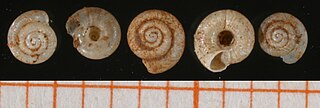
Hawaiia minuscula, common name the minute gem or minute gem snail, is a species of very small air-breathing land snail, a terrestrial pulmonate gastropod mollusk or micromollusk in the family Pristilomatidae.

Trogodendron fasciculatum or the yellowhorned clerid is a small beetle of the family Cleridae. T. fasciculatum is native to Australia, and feeds on other insects.
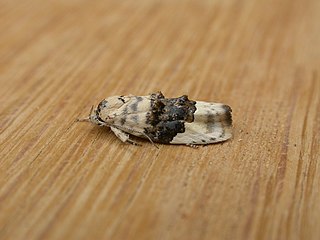
Piloprepes antidoxa is a moth of the family Oecophoridae. It is found in Australia.

The common Eupselia moth, Eupselia carpocapsella, is a species of moth of the family Depressariidae. It is found in Australia, where it has been recorded from New South Wales and South Australia.

Xylotrupes ulysses, common names "Elephant beetle", "Coconut palm beetle", "common rhinoceros beetle" or simply "rhinoceros beetle" is a species of rhinoceros beetle native to New Guinea. Male horns in several groups of this genus represent a special secondary sex characteristic. There is a bimodal horn-size distribution and there is a discrete male mating behavior correlated with each phenotype.
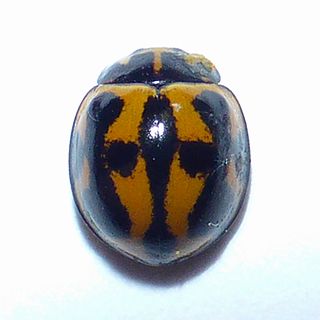
Coelophora inaequalis, the variable ladybird, common Australian lady beetle or common Australian ladybug is a ladybird species endemic to Australia, Oceania and Southern Asia. The variable ladybird gets its name from the black markings on the adult elytra, that vary from one individual to another.
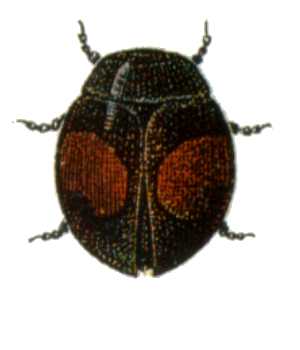
Diomus notescens, common name the minute two-spotted ladybird is a ladybird species endemic to the east and south of Australia.

Hednota is a genus of moths of the family Crambidae.

Harmonia conformis, the large spotted ladybird, is a species of ladybird. It has a light reddish appearance and its colouration includes 20 large black spots, 18 of which are found on the elytra. They are quite large for ladybirds, being about 6–7 mm long. It is a predator of other insects, eating aphids as both a larva and imago (adult). It is found in Australia, and has been introduced to New Zealand, where it is common in northern regions. Another member of the same genus, Harmonia antipodum, also occurs in New Zealand. This species, however, is a native and is much smaller and harder to find.
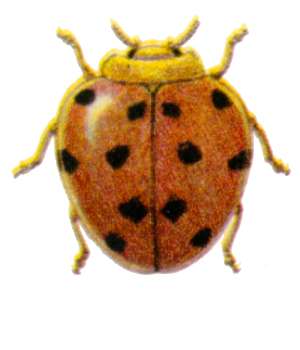
Henosepilachna sumbana, known commonly as the cucurbit ladybird, and sometimes listed as Henosepilachna cucurbitae is a pest ladybird species. H. sumbana feeds on cucurbits; vine-growing fruits such as melons, pumpkins, gourds, and cucumbers.

Henosepilachna vigintisexpunctata, common name twenty-six-spotted potato ladybird, is a ladybird species.
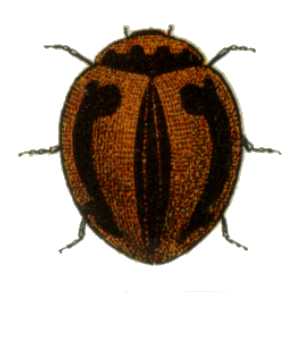
Micraspis frenata, common name Striped Ladybird, is a ladybird species endemic to Tasmania and the mainland eastern states of Australia.

Rhyzobius ventralis, common names including black lady beetle, gumtree scale ladybird, is a ladybird species endemic to Tasmania and all the mainland states of Australia except the Northern Territory. It is also found in New Zealand, but not naturally. The earliest New Zealand record is Auckland, 1898

Anisolabis is a genus of mostly Asian earwigs in the subfamily Anisolabidinae. It was cited by Srivastava in Part 2 of Fauna of India. The name Anisolabis stems from the asymmetry of the male cerci; the right cercus being more acute than the left.

The seashore earwig is a species of earwig in the family Anisolabididae. The species was first described in 1846 by Adam White. This species has a blackish-brown body with brown-yellow legs. It has two light brown spots on its head, close to the inside of each eye. Its abdomen is widest at the seventh segment. It is flightless. It is native to eastern Australia and New Zealand. Similar both ecologically and taxonomically to the maritime earwig, this species is commonly found on beaches under stones and debris. It is a carnivore, feeding on millipedes, flies, and isopods such as woodlice. Like most other earwigs, the females care for their young during development, and the larva go through five instars before becoming adults. The species also has a negative phototaxis, meaning that it tends to move away from a light source.
The Pacific earwig is a species of earwig in the genus Anisolabis, the family Anisolabididae and the order Dermaptera.
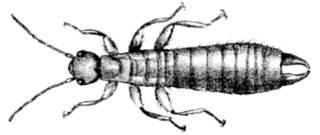
The Christmas Island earwig is a species of earwig in the family Anisolabididae.
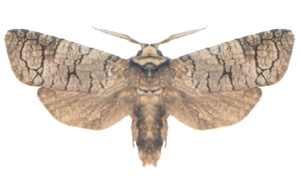
Zyganisus caliginosus, the Australian goat moth, is a moth of the family Cossidae. It is found in Tasmania, Victoria and New South Wales.

The Tasmanian cutworm is a moth of the family Noctuidae. It is found in Australia.
Ocybadistes knightorum is a butterfly in the family Hesperiidae, first described in 1994 by Trevor A. Lambkin and John F. Donaldson. It is endemic to New South Wales. It has a very limited distribution in the Boambee area. The IUCN Red List lists Ocybadistes knightorum as an endangered species, because of its limited known distribution, and its habitat under threat from weed invasion, sea-rise and continued development. The butterflies are restricted to coastal grassy open-forest areas, that are usually next to mangroves.


















